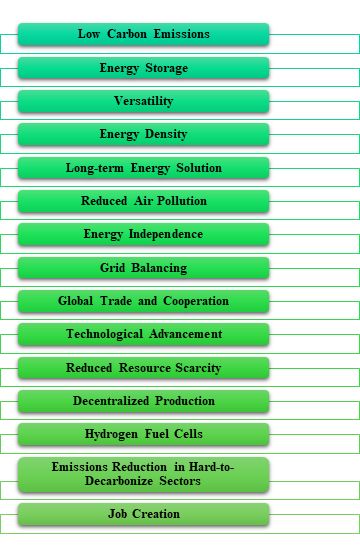1. INTRODUCTION
In a world where the pursuit of clean, sustainable energy sources has taken centre stage, Green Hydrogen has emerged as a shining beacon of hope. This remarkable substance holds the promise of revolutionizing our energy landscape by offering a clean and efficient solution to some of our most pressing environmental challenges. Green Hydrogen, often hailed as the fuel of the future, is hydrogen gas produced through a process that relies entirely on renewable energy sources, such as wind or solar power, resulting in a near-zero carbon footprint.
The production of Green Hydrogen represents a breakthrough in the quest to decarbonize our energy systems. Unlike conventional hydrogen production methods, which predominantly rely on fossil fuels and release significant greenhouse gas emissions, Green Hydrogen is produced through a process called electrolysis. During electrolysis, water is split into hydrogen and oxygen using electricity generated from renewable sources, leaving no harmful by-products. This fundamental shift in production methods holds the key to addressing some of the most pressing challenges of our time, including climate change and the transition away from fossil fuels.
The advantages of Green Hydrogen are manifold. Firstly, it serves as a versatile and efficient energy carrier. Hydrogen can be easily transported and stored, making it a viable option for a wide range of applications, from powering vehicles to industrial processes and even heating homes. Secondly, its production is inexhaustible, as long as renewable energy sources like sunlight and wind are available. This abundance ensures a reliable and sustainable energy supply, reducing our dependence on finite fossil fuels. Moreover, Green Hydrogen has the potential to create jobs and stimulate economic growth in regions with abundant renewable energy resources.
As we explore the prospects of Green Hydrogen, it becomes evident that this technology has the potential to reshape entire industries and foster a cleaner, more sustainable future. In the transportation sector, hydrogen fuel cells are emerging as a viable alternative to traditional internal combustion engines, offering longer ranges and quicker refuelling times while emitting only water vapour as a by-product. In industry, Green Hydrogen can replace the carbon-intensive processes that currently underpin manufacturing and chemical production. Additionally, it can serve as an energy storage solution, helping to balance the intermittency of renewable energy sources and provide stability to the grid.
However, realizing the full potential of Green Hydrogen requires overcoming numerous challenges, including the high initial costs of electrolysis equipment, the need for further advancements in renewable energy technology, and the development of a robust infrastructure for hydrogen production, distribution, and utilization. Despite these challenges, governments, industries, and researchers worldwide are investing heavily in the development and scaling of Green Hydrogen technology, recognizing its pivotal role in the global transition to a sustainable, low-carbon future.
Apart from Green Hydrogen, there exists a whole colour spectrum of Hydrogen:
- Blue Hydrogen: Blue hydrogen is primarily
generated from natural gas through a method known as steam
reforming, wherein natural gas is combined with heated steam to
yield hydrogen as the primary product. However, this process also
results in the production of carbon dioxide as a secondary output.
Consequently, the concept of blue hydrogen encompasses the
utilization of carbon capture and storage (CCS) to capture and
store this carbon.
At times, blue hydrogen is referred to as 'low-carbon hydrogen' since the steam reforming procedure does not completely prevent the generation of greenhouse gases. - Grey Hydrogen: At present, this represents the prevalent method of hydrogen generation. Grey hydrogen is derived from natural gas, specifically methane, through steam methane reformation, but it does not involve the capture of the greenhouse gases produced during the process. Essentially, grey hydrogen is identical to blue hydrogen, except it lacks the implementation of carbon capture and storage.
- Black and Brown Hydrogen: By employing black
coal or lignite, also known as brown coal, in the hydrogen
production process, both black and brown hydrogen occupy the
extreme end of the hydrogen spectrum and are highly detrimental to
the environment.
To add to the complexity, any hydrogen generated from fossil fuels through the gasification process is occasionally referred to as either black or brown hydrogen interchangeably. A recent announcement from Japan and Australia revealed a new initiative involving the utilization of brown coal in Australia to produce liquefied hydrogen. This hydrogen will subsequently be transported to Japan for low-emission applications. - Pink Hydrogen: Pink hydrogen is produced via electrolysis that is powered by nuclear energy. Hydrogen generated from nuclear sources can also be termed as either purple hydrogen or red hydrogen. Furthermore, the exceedingly high temperatures produced by nuclear reactors have the potential to be harnessed in alternative hydrogen production methods. This can involve generating steam for more efficient electrolysis or facilitating steam methane reforming, which may be based on fossil gas.
- Turquoise Hydrogen: This represents a recent addition to the hydrogen color spectrum, and its large-scale production is yet to be demonstrated. Turquoise hydrogen is manufactured using a technique known as methane pyrolysis, which yields hydrogen and solid carbon as its output. In the future, the value of turquoise hydrogen may hinge on whether the thermal process is driven by renewable energy and whether the carbon is either permanently stored or put to use, potentially positioning it as a low-emission hydrogen source.
- Yellow Hydrogen: Yellow hydrogen is a recently coined term referring to hydrogen produced through electrolysis powered by solar energy.
- White Hydrogen: White hydrogen is a naturally formed hydrogen that occurs in underground reservoirs and is generated through hydraulic fracturing (fracking). Currently, there are no plans to harness this hydrogen.
2. SIGNIFICANCE OF GREEN HYDROGEN
Green hydrogen is produced through the electrolysis of water using renewable energy sources such as wind or solar power. This process emits no greenhouse gases, making it a clean and environmentally friendly energy carrier. Hydrogen can be used as a means of energy storage, allowing excess renewable energy to be stored and used when needed, helping to balance grid fluctuations and support energy security. It can be used in a wide range of applications, including transportation, industry, heating, and electricity generation, making it a versatile energy carrier. Hydrogen has a high energy density by weight, which makes it suitable for applications where energy storage needs to be compact, such as in fuel cells for vehicles. Green hydrogen can play a crucial role in transitioning to a sustainable energy future. It can be produced in large quantities and used to replace fossil fuels in sectors that are difficult to decarbonize.
When used in fuel cells, hydrogen produces only water vapour as a by-product, reducing local air pollution and improving air quality in urban areas. Producing green hydrogen locally using renewable resources can enhance a region's energy independence and reduce reliance on imported fossil fuels. Hydrogen can act as a buffer for intermittent renewable energy sources, helping to stabilize the electricity grid and ensure a consistent power supply. Green hydrogen can be transported and traded globally, fostering international cooperation on clean energy solutions. The development and scaling up of green hydrogen technologies can drive innovation in renewable energy, electrolysis, and fuel cell technologies as well.

Figure 1: Significance of green hydrogen
Hydrogen can be produced from water, which is abundant, reducing concerns related to resource scarcity that can be associated with other energy carriers. Hydrogen can be produced
at various scales, from small-scale electrolysers for local applications to large industrial facilities, allowing for decentralized production and distribution. In transportation, hydrogen fuel cells offer fast refuelling, long driving ranges, and compatibility with heavy-duty vehicles like buses and trucks. Hydrogen can be used in industries like steel, chemicals, and aviation, where direct electrification may be challenging, helping to reduce emissions in these sector. The green hydrogen industry can create new jobs in manufacturing, infrastructure development, and research and development, helping stimulate economic growth.
Click here to continue reading . . .
This article is for information purpose only. It is not intended to constitute, and should not be taken as legal advice, or a communication intended to solicit or establish commercial motives with any. The firm shall not have any obligations or liabilities towards any acts or omission of any reader(s) consequent to any information contained herein. The readers are advised to consult competent professionals in their own judgment before acting on the basis of any information provided hereby.


